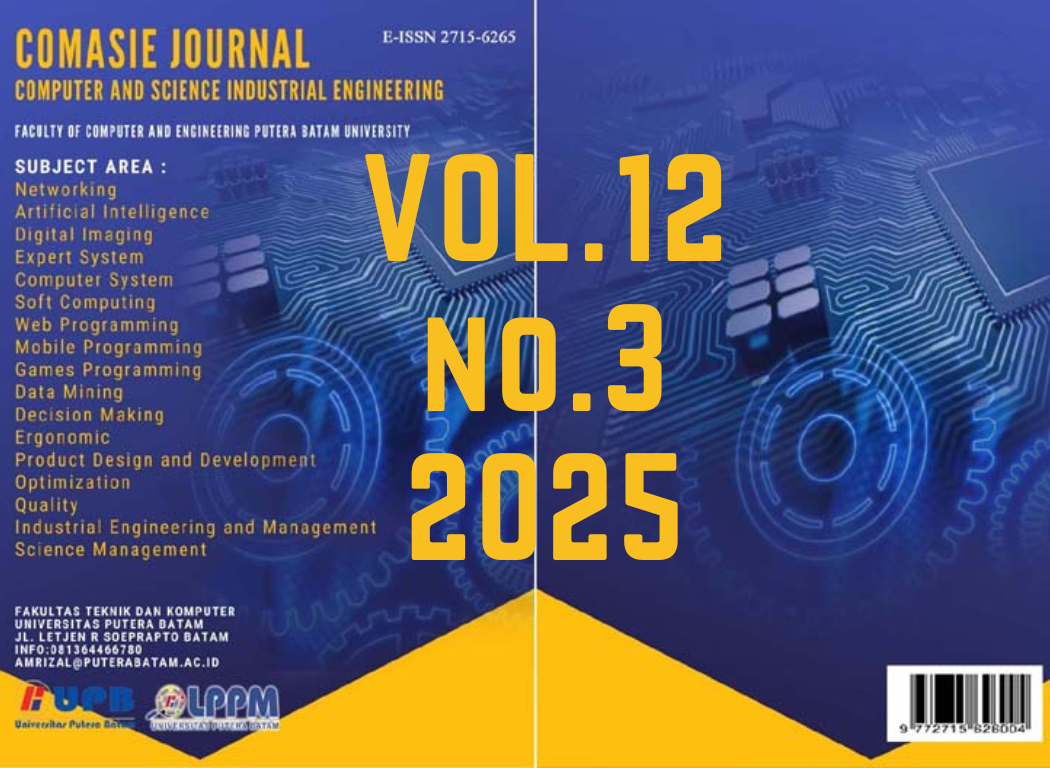ANALISIS KLASIFIKASI EMAIL SPAM MENGGUNAKAN ALGORITMA NAÏVE BAYES
DOI:
https://doi.org/10.33884/comasiejournal.v12i3.9792Keywords:
accuracy, class imbalance, naive bayes, smote, feature extractionAbstract
Spam emails pose a significant challenge in digital communication, requiring effective classification methods to enhance cybersecurity. This study evaluates the performance of the Naïve Bayes algorithm in detecting spam emails, focusing on accuracy, precision, and recall. The dataset consists of pre-labeled emails processed using TF-IDF for feature extraction. The results indicate that the algorithm achieved an accuracy of 90% before addressing class imbalance. After applying SMOTE, the final accuracy improved to 98%. These findings demonstrate that Naïve Bayes is an effective method for spam email classification, with SMOTE enhancing its performance in handling class imbalance.
References
Andriawan, M. G., & Ernawati, T. (2024). PENGGUNAAN ALGORITMA NAÏVE BAYES DAN SUPPORT VECTOR MACHINE UNTUK ANALISIS SENTIMEN KONFLIK PALESTINA DAN ISRAEL PADA PLATFORM X. Jurnal Informatika Dan Teknik Elektro Terapan, 12(3). https://doi.org/10.23960/jitet.v12i3.4943
Bachri, C. M., & Gunawan, W. (2024). Deteksi Email Spam menggunakan Algoritma Convolutional Neural Network (CNN).
Dixon, S. J. (2023, June 26). Average daily spam volume worldwide from October 2020 to September 2021. Statista. https://www.statista.com/statistics/1270424/daily-spam-volume-global/
Jaiswal, M., Das, S., & Khushboo. (2021). Detecting spam e-mails using stop word TF-IDF and stemming algorithm with Naïve Bayes classifier on the multicore GPU. International Journal of Electrical and Computer Engineering, 11(4), 3168–3175. https://doi.org/10.11591/ijece.v11i4.pp3168-3175
Kumar, A., Chatterjee, J. M., & Díaz, V. G. (2020). A novel hybrid approach of SVM combined with NLP and probabilistic neural network for email phishing. International Journal of Electrical and Computer Engineering, 10(1), 486–493. https://doi.org/10.11591/ijece.v10i1.pp486-493
Kurniawan, D. (2022). Pengenalan machine learning dengan python. Elex Media Komputindo.
Munir, N., Huang, J., Wong, C.-N., & Song, S.-J. (2024). Machine Learning Based Eddy Current Testing: A Review. Results in Engineering, 103724. https://doi.org/10.1016/j.rineng.2024.103724
Mesri Silalahi, & Saut Pintubipar Saragih. (2021). Perancangan Website Penyedia Informasi Promosi dan Diskon. JUSTIN (Jurnal Sistem Dan Teknologi Informasi), 9(2), 257–262. https://jurnal.untan.ac.id/index.php/justin/article/view/43463/75676589335
Saragih, S. P. T. I., & Harisno, H. (2015). Influence Of Knowledge Sharing and Information Technology Innovation on Employees Performance at Batamindo Industrial Park. CommIT (Communication and Information Technology) Journal, 9(2), 45. https://doi.org/10.21512/commit.v9i2.1657
Qodariyah Fitriyah, N., & Oktavianto, H. (2019). Deteksi Spam Pada Email Berbasis Fitur Konten Menggunakan Naïve Bayes. Jurnal Sistem Dan Teknologi Informasi Indonesia. https://archive.ics.uci.edu/ml/machine-
Taye, M. M. (2023). Understanding of Machine Learning with Deep Learning: Architectures, Workflow, Applications and Future Directions. In Computers (Vol. 12, Issue 5). MDPI. https://doi.org/10.3390/computers12050091
Wibisono, A. (2023). FILTERING SPAM EMAIL MENGGUNAKAN METODE NAIVE BAYES. In Teknologipintar.org (Vol. 3, Issue 4).














